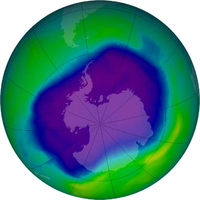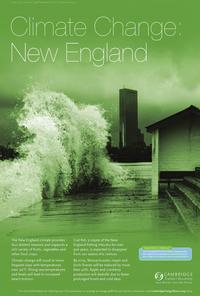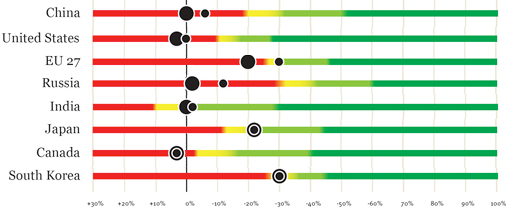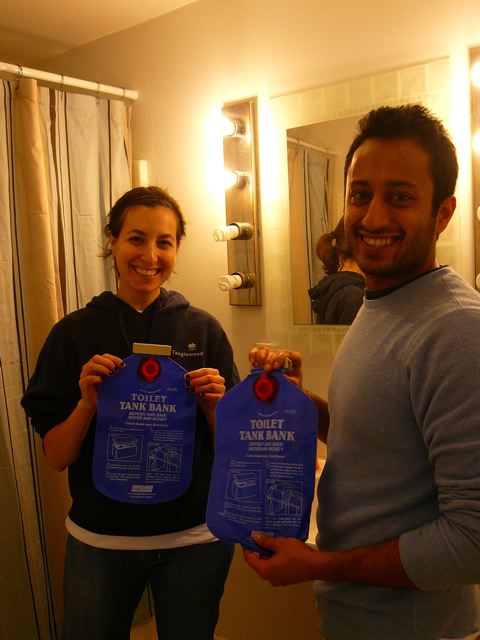 A reader submitted this link regarding a traveling exhibit dubbed “Seasons of Change” about global warming’s impact on New England. You can find it at the Ecotarium in Worcester through May, where you might also enjoy an Inspiring Breath of Spring! and other exhibits. Eventually, it will be accessible via public transportation at the Museum of Science, but not anytime this year.
A reader submitted this link regarding a traveling exhibit dubbed “Seasons of Change” about global warming’s impact on New England. You can find it at the Ecotarium in Worcester through May, where you might also enjoy an Inspiring Breath of Spring! and other exhibits. Eventually, it will be accessible via public transportation at the Museum of Science, but not anytime this year.
Tag Archives: Climate
Remember the rainforest?
 The poster child of human environmental destruction in the 90’s is still imperiled, even if the focus has shifted to global warming. Of course the two are intimately related, and besides the forests’ huge impacts on local watersheds—effectively creating their own rain—the forests’ trees and soils obviously have a major impact on the carbon cycle. Still, the onslaught upon the lungs of the world is not only unrelenting but expanding. Continue reading
The poster child of human environmental destruction in the 90’s is still imperiled, even if the focus has shifted to global warming. Of course the two are intimately related, and besides the forests’ huge impacts on local watersheds—effectively creating their own rain—the forests’ trees and soils obviously have a major impact on the carbon cycle. Still, the onslaught upon the lungs of the world is not only unrelenting but expanding. Continue reading
Extreme documentaries
Last week’s episode of NOVA Extreme Cave Diving was an interesting foray into “blue holes,” and the evidence they offer of paleo-climate. If you missed it, check the website to view it online. Similar, though less-breath taking evidence is offered in a recent paper from Yale.
This week’s Extreme Ice, provides a stunning and more in-depth review of the photographic documentation of glacial melting by James Balog, which we have mentioned before.
CEA debuts Climate Change Art Project
The Cambridge Energy Alliance is debuting a poster art exhibit to inform the public about climate change and its impacts, the carbon emissions of Cambridge, and how local citizens can make a difference. Over 80% of Cambridge’s Climate emissions come from residential and commercial buildings, so eliminating wasted energy in our homes and workplaces is a priority.
To view the full CEA art poster exhibit visit:
http://cambridgeenergyalliance.org/wp-content/uploads/posters.pdf
The Cambridge Energy Alliance art exhibit displays many ways people can conserve energy and get connected to efficiency programs and resources. The Exhibit will be on display from Wednesday, February 16th, 2010 through March 20th, 2010 at the Clear Conscience Café (C3) located inside Harvest Coop‘s Central Square location.
Following the 4-week showing at C3, the CEA art exhibit will be rotated to other locations throughout the city. You can preview the posters by clicking the thumbnail above.
Even with ‘Copenhagen,’ toasty times ahead
Last week I wrote about the post-COP15 emissions target deadline that whizzed by for most of the planet, and tried to put it into context. Of course, the larger question of what the resulting cuts would mean with regards to future warming remained unanswered, due to it being written during the wee hours of the morning. Fortunately, someone else also crunched the numbers and compared them to model predictions, New Scientist reports, arriving at a most unfortunate (but unsurprising) answer.
Cambridge to host 3rd Climate Congress
 A third Climate Congress will be held on Saturday, March 6, 2010, from 9am to noon, in City Hall. The Climate Congress is open to the public. The main aim will be for delegates to unite on specific recommendations for City action. The Congress will use the opportunity to decide on whether to accept a final report on proposals and to bring the new citizen action teams together.
A third Climate Congress will be held on Saturday, March 6, 2010, from 9am to noon, in City Hall. The Climate Congress is open to the public. The main aim will be for delegates to unite on specific recommendations for City action. The Congress will use the opportunity to decide on whether to accept a final report on proposals and to bring the new citizen action teams together.
During the second Climate Congress, 75 delegates convened to develop recommendations to the city for addressing climate change, but also organize and develop citizen generated solutions. Highlights from the second congress include:
- The Congress discussed priorities among the proposals in the Draft Report. Several common themes emerged and these will be documented in the final report of the Congress.
- Delegates formed action teams to work in specific areas: outreach, resilience, solar and other renewables, process for future climate emergency response (drafting), protection of trees and natural resources, building efficiency, and measurement . Several of these groups have already agreed to meet again. (If you are interested in participating in any of these groups contact Joanna Herlihy <joanna_herlihy@yahoo.com>)
- Recommendations for climate emergency response by the City were considered and received broad support. However, there were questions about the specifics and report structure, that required more time to consider. Those present unanimously agreed to meet again for a third session to address those questions.
For more information about the climate emergency and the Climate Congress visit: http://www.cambridgema.gov/deptann.cfm?story_id=2457&pv=Yes
55 countries down…?
 There’s a lot of press today about the fact that 55 countries have submitted emissions reduction pledges to the U.N. as the deadline drew passed; note that 27 of them are in the EU. New Scientist has a nice summary, and Reuters India lists most of the targets.
There’s a lot of press today about the fact that 55 countries have submitted emissions reduction pledges to the U.N. as the deadline drew passed; note that 27 of them are in the EU. New Scientist has a nice summary, and Reuters India lists most of the targets.
Some of the more disappointing targets include our own, our neighbors to the north, and Korea. “The US previously pledged a cut of 17% from 2005 levels by 2020 (equivalent to 3% from the conventional baseline of 1990)” (BBC). True to its word, the increasingly conservative Canadian government submitted the same relative target as the U.S. South Korea—whose emissions have more than doubled since 1990—has committed to an even smaller cut of 4% of 2005 levels. However, it has tries to play up the significance of these cuts by calling them a 30% cut from business as usual.
Below you can find a summary of the pledges of the top eight emitters (78%) of carbon dioxide, and what their effect might be. Please note that barring an international agreement in Mexico next winter, China and India’s targets are even less firm than those of other nations since they have vowed to decrease intensity (increase efficiency) by 40-45% & 16-20% respectively, rather than make cuts towards a specific target. These estimates are therefore a best case scenario under the unlikely condition of zero future growth.
| Baseline | 2007 | % Global | Cut | 2020 | |||
|---|---|---|---|---|---|---|---|
| MT CO2 | Year | MT CO2 | MT CO2 | ||||
| 1 | China | 6083.0 | 2007 | 6083.0 | 27.57% | 40.00% | 3649.8 |
| 2 | U.S. | 5857.1 | 2005 | 5853.5 | 26.53% | 17.00% | 4861.4 |
| E.U. | 4135.4 | 1990 | 3971.1 | 18.00% | 20.00% | 3308.3 | |
| 3 | Russia | 2302.6 | 1990 | 1579.0 | 7.16% | 20.00% | 1842.1 |
| 4 | India | 1369.9 | 2007 | 1369.9 | 6.21% | 16.00% | 1150.7 |
| 5 | Japan | 1069.4 | 1990 | 1235.1 | 5.60% | 25.00% | 802.1 |
| 8 | Canada | 543.4 | 2005 | 540.8 | 2.45% | 17.00% | 451.0 |
| 9 | South Korea | 361.4 | 2005 | 499.0 | 2.26% | 4.00% | 346.9 |
| World | 2007 | 29320.0 | 16.09% | 24600.9 | |||
MT = megatonne. approximately 2.2 billion pounds.
Countries 7 & 8 are the United Kingdom and Germany, both members of the European Union.
Sources: Emissions data, and pledges from stories linked in this post.
Green Shelter Project Underway at Transition House
Press Release: Green Shelter Project Underway at Transition House
Cambridge, MA — Transition House, Cambridge’s nonprofit domestic violence prevention agency, is greening its Emergency Shelter. The 120-year-old building buzzed with activity on Sunday, January 10, as Transition House kicked its Green Shelter Project into high gear with a modern-day weatherization barn-raising in partnership with the Home Energy Efficiency Team (HEET), the Cambridge Energy Alliance and New Generation Energy. “We were excited to have so many skilled and enthusiastic volunteers join together to make the Shelter more energy efficient and more comfortable for the 100 people who live there each year,” relayed Risa Mednick, chair of the Transition House Board. “We’re connecting the dots between environmental sustainability, energy conservation and sustaining vital programs in an era when domestic violence is on the rise and the needs of survivors far outstrips available resources.” “Every dollar we save on utility expenses will be redirected toward strengthening services our community depends on,” says Mednick.
Over 40 volunteers worked nonstop in groups led by HEET trainers sealing drafty basement leaks, caulking windows, installing low flow faucets and shower heads, replacing incandescent light bulbs with energy efficient compact florescents (CFLs) and weather stripping doorways. Former Mayor and City Councilor Denise Simmons, Councilor Sam Seidel and Councilor and State Representative Tim Toomey lent a hand. Transition House board members and the Middle East restaurant provided food for hungry workers. HEET donated all supplies and training and the Cambridge Energy Alliance donated CFL bulbs.
“In a few hours, we swapped out 50 light bulbs in 15 rooms, caulked all the windows and doors, fitted sinks with new aerators, and sealed over 140 feet of band joists that were a major source of heat loss,” reported Audrey Schulman, HEET’s president. Based on before and after measurements, HEET estimates a reduction of over $600 per year on heat and electricity bills. “We look for ways an organization like Transition House or an individual in their own home can realize big savings with small changes, says Schulman. One example: simply replacing the old bulbs in exit signs that operate 24/7 with high efficiency LEDs will save Transition House over $100 per year.
Chuck Lewin, founder of New Generation Energy ducked below basement pipes and beams as he sealed up air leaks remarking, “Every small thing each of us did here will have a lasting impact for Transition House. The environmental benefit can multiply if everyone applies what they’ve learned to their own homes and apartments.” HEET trainer Lilah Glick, of the Cambridge Energy Alliance led the team replacing thermostats with instruction in Spanish and English and shared that “programmable thermostats are an inexpensive way to reduce energy consumption, typically saving the average home over $150 dollars a year.”
Introducing low income homeless women to new skills that might spark their interest in green jobs and training opportunities is another important goal of the Green Shelter Project; engaging them in energy saving strategies as a part of budgeting and money management is also key.
Next steps for the organization include: continuing work with HEET to train staff and clients on changing work and lifestyle behaviors to increase energy conservation and savings; collaborating with New Generation Energy and the Cambridge Energy Alliance to monitor utility consumption patterns and assess the efficacy of renewable energy systems for the Emergency Shelter; and a green kitchen renovation.
###
About Transition House: Transition House, a nonprofit organization in Cambridge, MA, works to break the cycle of domestic violence. Transition House offers a continuum of safe, supportive housing options for individuals and families escaping abuse as well as prevention education in school and community settings. Since 1975, Transition House has been a lifeline to thousands of families as they rebuild their lives and has educated tens of thousands of youth in Cambridge and Greater Boston. www.transitionhouse.org
Partners in this green initiative include: the Home Energy Efficiency Team (www.heetma.org), Cambridge Energy Alliance (www.cambridgeenergyalliance.org) and New Generation Energy (www.newgenerationenergy.org) respected organizations with a shared interest in engaging public awareness and increasing participation in conservation and energy efficiency initiatives.
Super (secret) greenhouse gases
 Environmentalists had great expectations for “Hopenhagen,” and the talks received a lot of press long before they even rolled around. Yet another international meeting one month earlier was arguably of equal importance, foreshadowed the events in Denmark, and received almost no attention1: the annual meeting of Montreal Protocol signatories. Read Solve Climate founder David Sassoon’s write-up.
Environmentalists had great expectations for “Hopenhagen,” and the talks received a lot of press long before they even rolled around. Yet another international meeting one month earlier was arguably of equal importance, foreshadowed the events in Denmark, and received almost no attention1: the annual meeting of Montreal Protocol signatories. Read Solve Climate founder David Sassoon’s write-up.
1. None of the few dozen stories on Google News which mention the Montreal Protocol last year preceded the event. Most are specialist coverage of its impacts on various industries or countries still using CFCs, and a few others comment on Copenhagen by contrasting the successful effort to combat ozone depletion versus the relative lack of progress on global warming.
I’m melting
A brief and interesting Google Earthy video of global ice loss.
Continue reading




